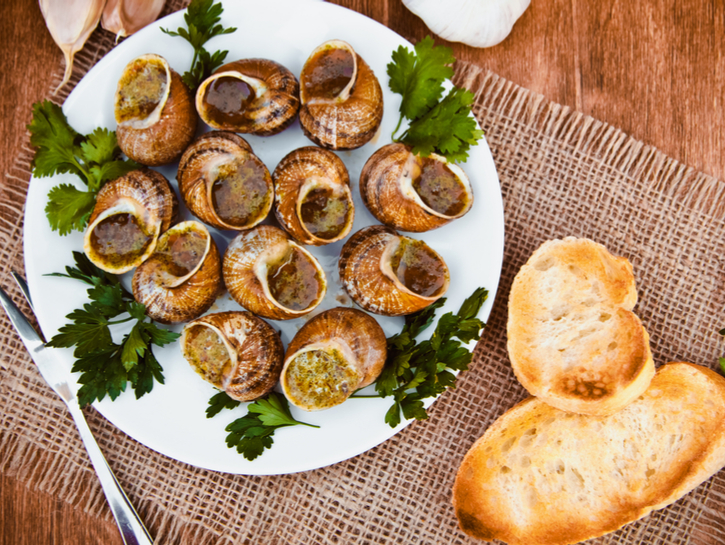What Is Escargot?
Escargot is a general term referring to cooked, edible snails and the various preparations of these shelled creatures. Large land snails, normally helix snails, are used when creating this dish. Although the idea of consuming snails may disgust the average American, this dish is prepared as a luxurious appetizer or entree in many Mediterranean and European countries, and it particularly famous in French cuisine. Escargot is often served with a butter and garlic sauce, yet other sauces, typically ones with alcohol bases including wine or brandy, are also commonly used.
If the concept of eating snails isn’t enticing to you yet, it’s worth considering that escargot is a reasonably health-conscious food. It is practically free of sugar and fat and is full of essential vitamins and minerals. Snails contain high levels of iron, magnesium, phosphorus and potassium, which are all required for adequate heart, brain and blood health.

shakim888/Shutterstock
Where Is Escargot From?
While this dish is mostly consumed as a delicacy in France today, escargot dates back to prehistoric times. Cave drawings were one of the first indicators that ancient humans consumed snails, and Paleolithic archaeological digs have turned up tens of thousands of empty snail shells that may have been consumed by ancient peoples.
About 10,000 years later, Mediterranean areas adopted the practice of eating the shelled creatures. The preparation and consumption of snails were mentioned in the first cookbook, Apicius, during the first century BC. In ancient Rome, this dish was regarded as a meal for the elite — historian Pliny described feeding the snails wine before they were eaten, reinforcing how prized these creatures were when it came to consuming them.
Escargot supposedly came to the U.S. in the 1850’s through immigrants who missed the delicacy from France and decided to replicate the recipe. Soon, snails sprung onto menus and became a popular luxury dish throughout the 19th century. By the 1980s, escargot represented a $300 million a year business in the U.S.
How Can You Prepare Escargot?
Although escargot may sound a bit complicated when it comes to tracking down the ingredients yourself, the dish is much easier to put together than the ingredients imply. Of course, you cannot grab any common snail from your garden to use for escargot because they may contain harmful contaminants from their natural diet that are unsafe for human consumption. Luckily, you can find canned helix snails for escargot at many grocery stores and online. Few places sell fresh snails that are safe for consumption, but if you’re able to track a location down that does, you can add an extra kick of freshness to your recipe.
To prevent foodborne illnesses, it’s essential to always cook your snails before consuming them. This is generally done by removing the snails from the can or their shells and cooking them in garlic butter, wine, brandy or other sauces. If you’re cooking them directly in their shell, you can broil the entire mixture of snail and sauce until the brew is bubbling and is ready to serve.

Mikhail_Kayl/Shutterstock
What Does Escargot Taste Like?
Although it depends on the sauce used, the most common way of preparing escargot — with butter and garlic — results in a rich, buttery, slightly spicy taste. However, preparing it with different ingredients or sauces will result in a different taste, as snails tend to absorb the flavor of the sauce they are coated or cooked in. Hence, preparing it with wine, brandy or other strong flavors will drastically alter the taste. Some compare the flavor to chicken, yet those who consistently consume the delicacy all agree that the dish has its own, special taste — and that it is absolutely incredible. No matter how you flavor it, the texture of cooked snails is usually rubbery, yet smooth and gooey, much like an oyster, clam or mushroom.
